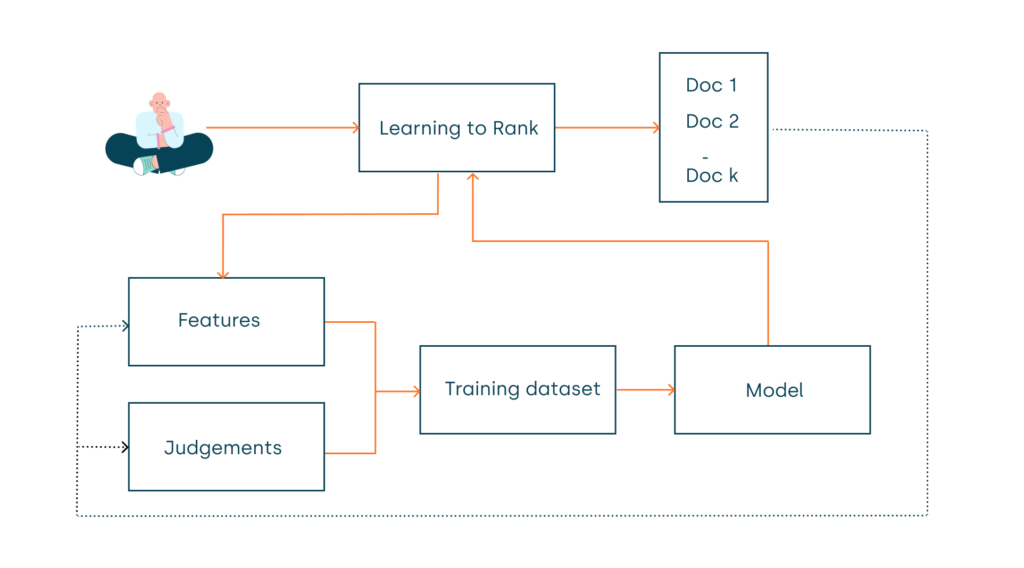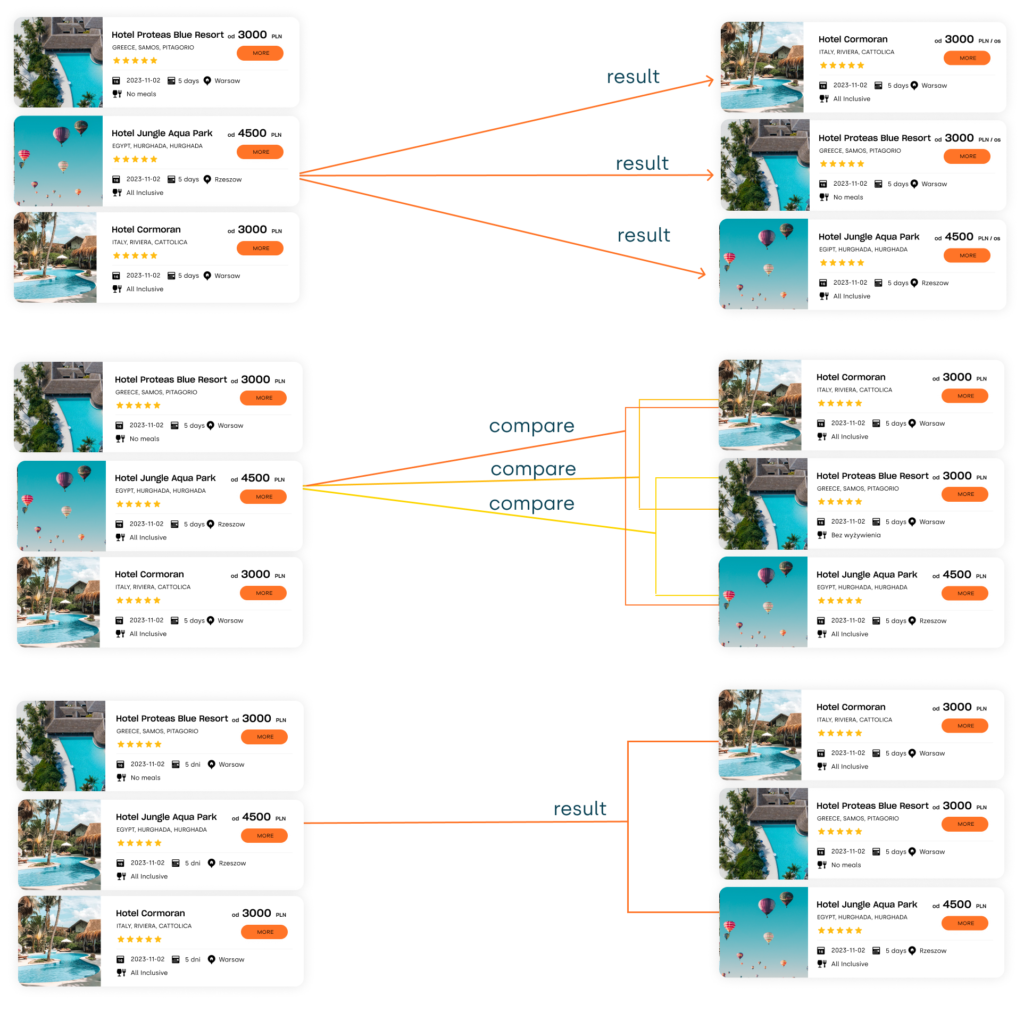Wondering how machine learning technologies are used to deliver personalized and accurate search results? Discover the ins and outs of “Learning to Rank” — the key to enhanced personalization in tourism and beyond. In this article, we’ll explain what’s behind the term, how it functions, and how it contrasts with recommendation systems. Additionally, we’ll discuss the various types of learning to rank algorithms and provide an illustrative application from the travel industry.
What is Learning to Rank?
The field of “Learning to Rank” (LTR) is a type of machine learning that specializes in developing techniques and algorithms for sorting and ranking data sets in the appropriate order. It is typically applied in applications related to natural language processing (NLP), information retrieval, and recommendations.
Learning to Rank in Tourism
In the travel domain, LTR can be implemented to offer individualized recommendations to users by analyzing search queries. For instance, when a user searches for flights from New York to London, LTR can rank the results in order of relevance based on several factors, such as flight duration, price, and departure time. This ensures that the user receives the most suitable results and saves time by not having to sift through irrelevant options.
Learning to Rank in e-commerce
In the e-commerce industry, LTR can be implemented to provide personalized product recommendations to customers by analyzing their purchasing preferences. For example, when a customer browses an online store for clothes, the model can provide recommendations based on various factors such as brand, size, season, and color.
An important factor is CTR (Click-Through Rate), which refers to the ratio of the number of clicks to the number of product views. For example, if a product has a high CTR, it means that it is attractive to customers and probably meets their expectations. In this case, the model can prioritize recommendations of similar products that achieve high CTR. Optimizing the model taking into account CTR allows you to increase the chances of clicking on the product and ultimately increase sales for the online store. The LTR solution is used on the Amazon e-commerce website.
How Does the Re-Ranking Process Work?
The primary purpose of Learning to Rank is to teach a model how to arrange a set of documents or items in a manner that is consistent with the user’s intentions. In a ranking recommender system, there is a catalog of items. When a user interacts with the system, it retrieves relevant items and arranges them in order of relevance.

Example Application of Re-Ranking in the Tourism Industry
To illustrate how the re-ranking process works, let’s consider the following scenario:
Imagine a search engine system specializing in offering travel trip suggestions to users. The system’s primary objective is to present travel itineraries that align with users’ preferences and interests. However, it’s equally important to balance offering popular, well-visited, and unique travel destinations.
Initially, the system arranges travel trip options based on their popularity. This ranking could consider metrics such as the number of travelers who have explored these trips or user reviews. Consequently, the most widely visited travel destinations rise to the top of the search results. However, some users may prefer discovering lesser-known or niche travel experiences.
To address this, the system integrates a recommender algorithm that factors in a user’s personal preferences by interpreting their search queries. When a user initiates a search for travel trips, the system takes into consideration both the initial popularity ranking and the personalized recommendations. It might begin by showcasing a selection of popular travel itineraries at the beginning of the search results. The system can refine the search results and recommendations by considering a specific user’s search.
In this way, the system combines the benefits of both popularity and personalization. It ensures that users are exposed to popular travel destinations while adapting their preferences, thereby avoiding the extremes of offering only mainstream travel options.
Types of Learning to Rank Algorithms
LTR algorithms belong to the category of supervised learning, which means they require input and output data. In the context of LTR, the input is typically a user ID, while the output is a list ranked according to relevance to the user’s search query.
Some of the most commonly used LTR algorithms employ deep neural networks designed to learn and recognize complex patterns in data. Other LTR algorithms use boosting, combining multiple weaker models to create a stronger model, or decision trees, which are used to classify data based on a series of binary decisions By utilizing these sophisticated algorithms, LTR systems can effectively learn to rank data based on a wide range of factors and improve their accuracy over time.
There are three main types of LTR algorithms: pointwise, pairwise, and listwise. The selection of the algorithm relies on the particular task at hand. In the following sections, we will discuss each type of algorithm in more detail.

1. Pointwise Methods
Pointwise methods produce a score for each item and rank them accordingly. These algorithms transform the ranking problem into a regression or classification task. Each data point is treated independently, and the algorithm aims to predict the importance of a specific item in the ranking context. Pointwise methods are simple and easy to implement, but they do not take into account the relationships between items.
2. Pairwise Methods
Pairwise methods are binary classifiers that take two items and return an ordering of them. When discussing pairwise ranking, the output is optimized so that the number of inversions between items is minimized compared to the optimal rank of the items. An inversion is when two items switch places. To do the pairwise ordering, you need an absolute ordering. An absolute ordering means that for any two content items in the catalog, you can say one is more relevant than the other or is tied. These algorithms compare pairs of items in the dataset and learn which one is more suitable. Pairwise methods are more complex than pointwise methods, but they consider the relationships between items.
3. Listwise Methods
Listwise methods are the most comprehensive LTR subgroup because they optimize the entire ranked list. The advantage of listwise ranking is that it recognizes that ordering is more important at the top of a ranked list than at the bottom. Listwise methods treat the entire set of documents as one list and seek to optimize the ranking of the entire list.
Explaining recommender systems and LTR
Recommender systems are designed to make predictions about user preferences and ratings for specific items. These systems aim to estimate how much a user will like a particular item and assign a score or rating to it. For instance, a travel recommendation system may predict that a user would rate items with 4 out of 5 stars and suggest those items accordingly.
On the other hand, LTR algorithms do not predict ratings but instead focus on determining the optimal order or ranking for a list of items . LTR algorithms are concerned with producing ordered lists of items based on their relevance or importance, making them more suitable for scenarios where the order of presentation matters, such as search engines and content ranking. In a search engine, the LTR algorithm determines the order of search results, with the most relevant results appearing at the top. It is also used in content recommendation scenarios where the order of recommended items matters.
What Is the Difference Between Predicting Grades and Ranking?
In machine learning, LTR is a crucial subfield that plays a significant role in search engine applications. LTR is a set of algorithms that are used to train recommenders and other data-driven applications to produce ordered lists.
Unlike rating recommendation systems, LTR doesn’t focus on correctly predicting ratings but instead concentrates on creating lists of items ranked appropriately. The primary goal of LTR is to provide the most relevant results for a particular user query.
The difference between rating prediction and ranking is that ranking emphasizes the position of an item in the list and not the actual score. In other words, it doesn’t matter if an item has a high score or is within a rating scale as long as the score represents the position of the item in the rank.
Conclusion
To sum up, an analogy relevant to the main topic is that LTR is like a coach who trains a team to win games. Like a coach teaches a team to work together, LTR trains algorithms to produce ordered lists. The coach and Learning to Rank focus on building a team or a list that is ranked appropriately rather than just focusing on individual ratings or performance.
If you’re interested in delving deeper into the technical concepts of artificial intelligence, subscribe to our newsletter. You’ll then receive a monthly dose of solid knowledge straight to your inbox.